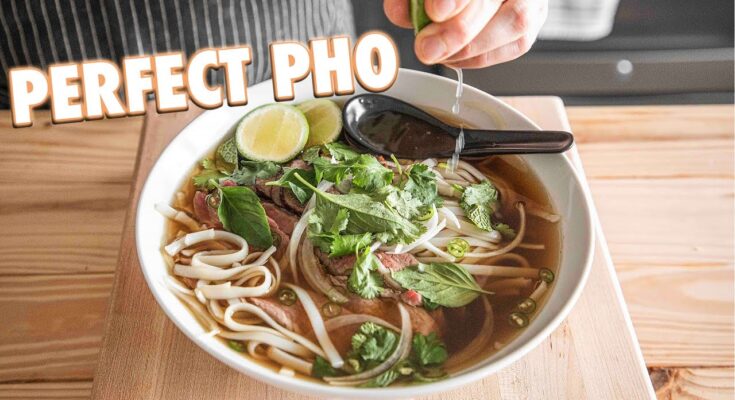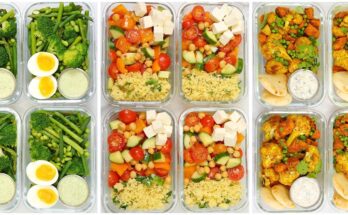Beef Pho Recipe: Beef Pho, known as “Phở Bò” in Vietnamese, is a soul-warming noodle soup that captures the essence of Vietnam’s culinary tradition. It’s more than just soup—it’s a cultural emblem. This aromatic dish features a flavorful broth brewed with beef bones, charred onions, ginger, and a medley of warming spices like star anise, cloves, and cinnamon. Traditionally served with rice noodles, thinly sliced raw beef, and fresh herbs, it’s a perfect blend of savory, spicy, and umami notes that keep you coming back for more.
What sets pho apart is its meticulous preparation process. The broth simmers for hours, extracting marrow and flavor from the beef bones, which creates that silky, deep taste everyone craves. It’s not just about eating; it’s about experiencing a tradition that dates back to early 20th-century Vietnam.
Why You’ll Love This Dish
What makes Beef Pho truly irresistible is its balance—rich yet clean, spicy yet soothing. It’s comfort food that doesn’t weigh you down. Whether you’re nursing a cold, looking for a hearty meal, or wanting to impress dinner guests with your culinary skills, pho fits the bill.
This dish is also incredibly customizable. You can play with the toppings—fresh herbs like cilantro and Thai basil, bean sprouts, chili slices, lime wedges, or even a splash of hoisin or sriracha sauce. It caters to all palates. Plus, once you’ve made it a couple of times, you’ll realize it’s not as intimidating as it seems.
Ingredients Needed for Beef Pho
For the Broth
Creating a rich, authentic pho starts with the right ingredients. Here’s what you’ll need for a classic beef broth:
- 3–4 lbs beef bones (preferably marrow bones and knuckles)
- 1 large onion (halved and charred)
- 1 large piece of ginger (4 inches, halved and charred)
- 1 cinnamon stick
- 2 star anise
- 4 whole cloves
- 1 tbsp coriander seeds
- 1 cardamom pod
- 1 tbsp salt
- 1 tbsp sugar (rock sugar is preferred)
- 2 tbsp fish sauce
- 5–6 quarts water
These ingredients work in harmony to develop that signature pho flavor—earthy, slightly sweet, deeply savory, and fragrant.
For the Pho Bowl Assembly
Once your broth is done, you’ll need the following for the final bowl:
- 1 lb rice noodles (flat, medium-width pho noodles)
- 1/2 lb thinly sliced raw beef (sirloin or eye of round)
- Fresh bean sprouts
- Thai basil
- Cilantro
- Mint leaves (optional)
- Lime wedges
- Thinly sliced onion
- Jalapeños or Thai chili slices
- Hoisin sauce and sriracha (for serving)
Each ingredient adds its own unique flair, whether it’s the crunch from bean sprouts, the aromatic lift from herbs, or the zing from lime and chili.
Preparing the Beef Pho Broth
Roasting Bones and Aromatics
The first and most critical step is developing the broth. Preheat your oven to 450°F (230°C). Place the beef bones on a baking tray and roast them for 30–40 minutes. This caramelizes the exterior, enhancing the broth’s depth.
While the bones roast, char the onion and ginger over an open flame or in a hot, dry skillet until blackened. This process gives the broth a smoky edge that’s quintessential to traditional pho.
Simmering and Skimming
Transfer the roasted bones to a large stockpot and fill with water. Bring to a boil, then reduce to a gentle simmer. Skim off any scum that rises to the top—this ensures a clear, clean broth. After about an hour, add the charred onion and ginger, followed by the spices (you can toast them beforehand for extra aroma).
Let everything simmer gently for at least 6–8 hours. The longer, the better—this slow cooking draws out the marrow, collagen, and flavors from the bones and aromatics.
Seasoning the Broth
Once the broth is deeply flavorful, strain it through a fine mesh sieve or cheesecloth to remove solids. Return the liquid to the pot and season with salt, sugar, and fish sauce. Adjust according to your taste preferences. Some like it saltier, while others prefer a sweeter, more aromatic profile.
This is the heart of your pho—the broth. Everything else supports this centerpiece.
Prepping the Noodles and Beef
Choosing the Right Noodles
Pho noodles are made from rice and come in varying thicknesses. For beef pho, medium-width flat noodles work best. You can find these fresh or dried at most Asian markets. Soak the dried noodles in warm water for about 30 minutes or boil fresh ones for a few seconds until soft but not mushy. Drain and rinse with cold water to stop the cooking.
The goal is to have noodles that are soft but chewy, able to absorb the flavorful broth without falling apart.
Selecting the Right Cut of Beef
Thinly sliced raw beef is one of pho’s signature elements. Sirloin, eye of round, or even tenderloin are ideal because they cook quickly when hot broth is poured over them. Ask your butcher to slice the beef paper-thin, or freeze the meat for 30 minutes to make slicing easier at home.
This thin slicing technique lets the beef gently cook in the hot broth, adding richness to your bowl without overcooking the meat.
Assembling the Perfect Bowl
Layering the Bowl
Now comes the exciting part—putting it all together. Think of it as crafting a delicious masterpiece in a bowl. Start by placing a generous portion of softened rice noodles in each serving bowl. Next, lay your thinly sliced raw beef over the noodles. You don’t need to cook the beef beforehand—the hot broth will handle that in seconds.
Ladle the steaming hot broth directly over the noodles and beef. The heat of the broth not only cooks the beef but also melds all the flavors together in a harmonious blend. Add a few thinly sliced onions on top to enhance the aroma and texture. If you like your pho extra meaty, feel free to add cooked beef brisket or beef meatballs.
Let the broth sit for a minute—this gives the beef time to gently cook through while absorbing all that goodness from the broth.
Toppings and Garnishes
Toppings are where you can truly personalize your pho. On a platter, offer bean sprouts, fresh Thai basil, cilantro, mint leaves, lime wedges, and thin chili slices. Each of these toppings serves a purpose—basil adds fragrance, sprouts give crunch, lime brings brightness, and chilies add that fiery kick.
Many also enjoy adding hoisin sauce or sriracha directly into the broth or as a dipping sauce for the beef. There’s no right or wrong—go with what pleases your taste buds. Stir it up, slurp those noodles, and enjoy the contrast of hot, cool, crunchy, spicy, and savory all in one bite.
This DIY assembly line not only makes for a fun dining experience but also ensures everyone gets exactly the bowl they crave.
Tips for the Best Homemade Pho
Common Mistakes to Avoid
Let’s face it—pho can be intimidating the first time. But here are a few mistakes to watch out for:
- Rushing the broth – The magic of pho lies in its slow-simmered broth. Cutting corners will leave you with a flat, uninspired soup.
- Skipping the skimming – If you don’t skim the broth, you’ll end up with a cloudy, greasy result that lacks the signature clarity pho is known for.
- Over-seasoning too early – Always season your broth towards the end. As it reduces, flavors concentrate, so early seasoning can throw things off balance.
- Not charring aromatics – Charring onion and ginger gives your broth that deep, smoky undertone that’s unmistakably Vietnamese.
- Using the wrong cut of beef – Tough cuts won’t tenderize quickly. Go for thin, lean slices that will cook in the bowl.
Avoiding these pitfalls ensures your beef pho turns out restaurant-quality, even if it’s your first time making it.
Time-Saving Hacks
Let’s be real—not everyone has eight hours to simmer broth. Here are some shortcuts:
- Pressure cooker or Instant Pot – You can drastically cut down simmer time using these gadgets, getting great results in a fraction of the time.
- Make broth in batches – Freeze portions of broth so you always have some on hand for a quick pho fix.
- Use pre-chopped aromatics and spice sachets – Many Asian markets offer pho spice blends in mesh pouches for convenience.
- Keep pho noodles pre-soaked – Store soaked noodles in water in the fridge for a few days. Just drain and heat when ready to use.
These hacks won’t give you traditional perfection, but they’re great when you’re short on time and still craving that comforting bowl of pho.
Customizing Your Beef Pho
Vegetarian and Low-Carb Alternatives
Though traditional beef pho is meat-heavy, there’s plenty of room for customization. Want to make a vegetarian version? Use roasted vegetables like onions, mushrooms, carrots, and daikon to create a hearty broth. Add tofu or seitan as your protein source. Use vegetable broth as your base, infused with the same spices used in beef pho—cinnamon, star anise, cloves, and coriander—for that authentic taste.
Looking to cut carbs? Swap the rice noodles with spiralized zucchini or shirataki noodles. These low-carb alternatives still deliver on texture while keeping things light and keto-friendly.
You can also go gluten-free by ensuring your fish sauce is certified gluten-free, and by skipping hoisin sauce unless it’s labeled safe for those with sensitivities.
Making It Spicier or Milder
Pho can be tailored to suit any spice level. Want more heat? Add Thai bird chilies, jalapeños, or a generous squirt of sriracha. Prefer it mild? Stick with the aromatic herbs and a squeeze of lime—still delicious without the burn.
This versatility makes beef pho an ideal dish to serve guests with varying tastes. Each bowl becomes a personalized experience, built to please.
Storing and Reheating Leftover Pho
Best Practices for Storing
One of the joys of pho is how well it stores. You can make a large batch of broth and use it over several days. Just remember: always store components separately.
- Broth: Cool and refrigerate in airtight containers for up to 5 days or freeze for up to 3 months.
- Noodles: Store separately in a bit of water to prevent sticking. Best used within 2–3 days.
- Meat and toppings: Keep raw beef slices tightly sealed and use within 1–2 days. Herbs and veggies should be stored dry and unwashed until needed.
This separation ensures that when you’re ready for a bowl, everything still tastes fresh.
How to Reheat Without Losing Flavor
To reheat pho:
- Bring the broth to a rolling boil—this is essential for cooking raw beef slices when you pour it over.
- Warm the noodles by dipping them in boiling water for a few seconds.
- Assemble the bowl as usual—noodles, beef, toppings—then ladle hot broth over it.
Avoid microwaving fully assembled pho—it turns mushy and dull. Always reheat broth separately for best results.
FAQs About Beef Pho Recipe
Q1: What type of beef is best for pho?
A: Traditionally, beef brisket, flank, and eye of round are most popular. For extra flavor, oxtail and beef shank can also be added to the broth.
Q2: How long should I simmer the beef broth?
A: For a deeply rich and aromatic broth, simmer it low and slow for at least 4–6 hours. The longer, the better—some simmer up to 10 hours!
Q3: Can I make beef pho ahead of time?
A: Absolutely. You can make the broth a day or two ahead, refrigerate it, and then reheat when ready to serve. It actually tastes better the next day.
Q4: Is beef pho gluten-free?
A: Yes, if you use gluten-free fish sauce and rice noodles (which are naturally gluten-free), pho can easily be gluten-free.
Q5: What herbs and toppings go best with beef pho?
A: Classic toppings include fresh basil, cilantro, bean sprouts, lime wedges, thinly sliced onions, and chili peppers. Customize it to your taste!
Q6: Can I use store-bought broth for pho?
A: Technically yes, but for that authentic depth and umami, homemade beef broth with roasted bones and spices wins every time.
Q7: What are the essential spices for pho broth?
A: You’ll want star anise, cinnamon sticks, cloves, cardamom pods, coriander seeds, and toasted ginger and onion for that signature Vietnamese aroma.
Q8: How do I keep the beef slices tender?
A: Slice the beef super thin—preferably while it’s slightly frozen—and pour the hot broth directly over it to cook it gently.
Conclusion
Beef pho isn’t just another bowl of soup. It’s a culinary journey—a celebration of bold flavors, patience, and creativity. The hours spent simmering bones and carefully layering herbs and spices pay off in every comforting, fragrant spoonful.
Whether you’re serving it for a weekend family dinner, nursing a cold, or impressing friends at a dinner party, beef pho always hits the spot. Once you master the basics, it becomes a versatile dish that can be adapted and reimagined in countless ways.
So next time you’re craving something warm, satisfying, and a little exotic—roll up your sleeves and make a pot of pho. Your taste buds (and your kitchen) will thank you.



